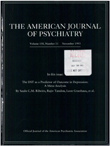An empirical study of diagnostic criteria for delirium
Abstract
OBJECTIVE: The objective of this study was to determine empirically how many patients are identified as delirious or nondelirious according to DMS-III, DMS-III-R, and ICD-10 criteria. METHOD: Daily, a trained research assistant using a structured instrument to detect the presence of symptoms of delirium evaluated 325 elderly patients who were admitted to a general hospital for acute medical problems. Each patient's symptoms were then compared with these diagnostic criteria sets to determine if the patient met criteria for delirium. RESULTS: DSM-III criteria were the most inclusive: they identified 125 patients as delirious. DSM-III-R identified a somewhat different group of 106 patients as delirious. ICD-10 criteria identified only 30 patients as delirious. CONCLUSIONS: The development of new criteria for delirium (e.g., DSM-IV) will have to balance the need to define a pure group of patients for research purposes with the need to include cases of clinical interest. Changes in criteria should be based on data such as those presented in this paper.
Access content
To read the fulltext, please use one of the options below to sign in or purchase access.- Personal login
- Institutional Login
- Sign in via OpenAthens
- Register for access
-
Please login/register if you wish to pair your device and check access availability.
Not a subscriber?
PsychiatryOnline subscription options offer access to the DSM-5 library, books, journals, CME, and patient resources. This all-in-one virtual library provides psychiatrists and mental health professionals with key resources for diagnosis, treatment, research, and professional development.
Need more help? PsychiatryOnline Customer Service may be reached by emailing [email protected] or by calling 800-368-5777 (in the U.S.) or 703-907-7322 (outside the U.S.).



